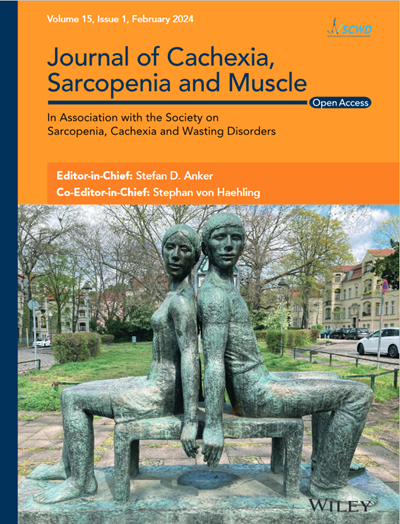Adenosine monophosphate-activated protein kinase is elevated in human cachectic muscle and prevents cancer-induced metabolic dysfunction in mice
Abstract
Background
Metabolic dysfunction and cachexia are associated with poor cancer prognosis. With no pharmacological treatments, it is crucial to define the molecular mechanisms causing cancer-induced metabolic dysfunction and cachexia. Adenosine monophosphate-activated protein kinase (AMPK) connects metabolic and muscle mass regulation. As AMPK could be a potential treatment target, it is important to determine the function for AMPK in cancer-associated metabolic dysfunction and cachexia. We therefore established AMPK's roles in cancer-associated metabolic dysfunction, insulin resistance and cachexia.
Methods
In vastus lateralis muscle biopsies from n = 26 patients with non-small cell lung cancer (NSCLC), AMPK signalling and protein content were examined by immunoblotting. To determine the role of muscle AMPK, male mice overexpressing a dominant-negative AMPKα2 (kinase-dead [KiDe]) specifically in striated muscle were inoculated with Lewis lung carcinoma (LLC) cells (wild type [WT]: n = 27, WT + LLC: n = 34, mAMPK-KiDe: n = 23, mAMPK-KiDe + LLC: n = 38). Moreover, male LLC-tumour-bearing mice were treated with (n = 10)/without (n = 9) 5-aminoimidazole-4-carboxamide ribonucleotide (AICAR) to activate AMPK for 13 days. Littermate mice were used as controls. Metabolic phenotyping of mice was performed via indirect calorimetry, body composition analyses, glucose and insulin tolerance tests, tissue-specific 2-[3H]deoxy-d-glucose (2-DG) uptake and immunoblotting.
Results
Patients with NSCLC presented increased muscle protein content of AMPK subunits α1, α2, β2, γ1 and γ3 ranging from +27% to +79% compared with control subjects. In patients with NSCLC, AMPK subunit protein content correlated with weight loss (α1, α2, β2 and γ1), fat-free mass (α1, β2 and γ1) and fat mass (α1 and γ1). Tumour-bearing mAMPK-KiDe mice presented increased fat loss and glucose and insulin intolerance. LLC in mAMPK-KiDe mice displayed lower insulin-stimulated 2-DG uptake in skeletal muscle (quadriceps: −35%, soleus: −49%, extensor digitorum longus: −48%) and the heart (−29%) than that in non-tumour-bearing mice. In skeletal muscle, mAMPK-KiDe abrogated the tumour-induced increase in insulin-stimulated TBC1D4thr642 phosphorylation. The protein content of TBC1D4 (+26%), pyruvate dehydrogenase (PDH; +94%), PDH kinases (+45% to +100%) and glycogen synthase (+48%) was increased in skeletal muscle of tumour-bearing mice in an AMPK-dependent manner. Lastly, chronic AICAR treatment elevated hexokinase II protein content and normalized phosphorylation of p70S6Kthr389 (mTORC1 substrate) and ACCser212 (AMPK substrate) and rescued cancer-induced insulin intolerance.
Conclusions
Protein contents of AMPK subunits were upregulated in skeletal muscle of patients with NSCLC. AMPK activation seemed protectively inferred by AMPK-deficient mice developing metabolic dysfunction in response to cancer, including AMPK-dependent regulation of multiple proteins crucial for glucose metabolism. These observations highlight the potential for targeting AMPK to counter cancer-associated metabolic dysfunction and possibly cachexia.

 求助内容:
求助内容: 应助结果提醒方式:
应助结果提醒方式:


